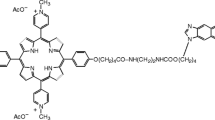Abstract
Changes in the relative quantum yield and polarization degree of steady-state fluorescence of daunomycin (DM) on its binding to six synthetic single- and double-stranded polynucleotides of various nucleotide compositions were measured over a wide range of molar polymer-to-dye ratios, in solutions of low ionic strength. Guanine base was found to be an effective quencher of DM fluorescence [in the DM–poly(G) complex the intensity of residual emission was ~0.5% of the free dye intensity]. The quenching of DM fluorescence by another purine base, i.e., adenine, was also revealed. But, unlike guanine, adenine exhibits quenching activity when it is in close contact with the DM chromophore, as realized in the complex with single-stranded poly(A). In intercalative complexes with double-stranded nucleic acids, where such contact is lacking, the quenching ability of adenine does not manifest itself, which has been demonstrated with the DM–poly(A) · poly(U) complex. It was found that the interaction with pyrimidine bases does not substantially change the DM quantum yield. The quenching feature of DM fluorescence is identical to that observed earlier by us for a glycoside phenazine dye containing, like DM, a neutral chromophore.
Similar content being viewed by others
REFERENCES
N. T. Thuong and C. Helene (1993) Angew. Chem. Int. Ed. Engl. 32, 666–690.
V. F. Zarytova, T. S. Godovikova, T. V. Maltseva, and D. S. Sergeev (1991) Nucleosides Nucleotides 10, 575–577.
A. Garbesi, S. Bonazzi, S. Zanella, M. L. Capobianco, G. Giannini, and F. Arcamone (1997) Nucleic Acids Res. 25, 2121–2128.
V. L. Makitruk, S. N. Yarmoluk, A. S. Shalamay, and I. V. Alexeeva (1991) Nucleic Acids Symp. Ser. 24, 244.
V. Zozulya, Yu. Blagoi, G. Löber, I. Voloshin, S. Winter, V. Makitruk, and A. Shalamay (1997) Biophys. Chem. 65, 55–63.
V. N. Zozulya, V. F. Fyodorov, and Yu. P. Blagoi (1990) Stud. Biophys. 137, 17–28.
S. Neidle (1979) Prog. Med. Chem. 65, 151–220.
G. J. Quigley, A. H.-J. Wang, G. Ughetto, G. van der Marel, J. H. van Boom, and A. Rich (1980) Proc. Natl. Acad. Sci. USA 77, 7204–7208.
J. B. Chaires (1983) Biochemistry 22, 4204–4211.
G. Löber (1981) J. Luminesc 22, 221–265.
L. Kittler, G. Löber, F. A. Gollmick, and H. Berg (1980) J. Electroanal. Chem. 116, 503–511.
J. M. Kelly, W. J. M. van der Putten, and D. J. McConnell (1987) Photochem. Photobiol. 45, 167–175.
G. S. Beddard, J. M. Kelly, and W. J. M. van der Putten (1990) J. Chem. Soc. Chem. Commun. 1346–1347.
D. A. Dunn, V. H. Lin, and I. E. Kochevar (1991) Photochem. Photobiol. 53, 47–56.
P. A. Mirau, R. H. Shafer, T. L. James, and P. H. Bolton (1982) Biopolymers 21, 909–921.
Author information
Authors and Affiliations
Rights and permissions
About this article
Cite this article
Zozulya, V. Fluorescence Properties of Intercalating Neutral Chromophores in Complexes with Polynucleotides of Various Base Compositions and Secondary Structures. Journal of Fluorescence 9, 363–366 (1999). https://doi.org/10.1023/A:1020548326983
Issue Date:
DOI: https://doi.org/10.1023/A:1020548326983



